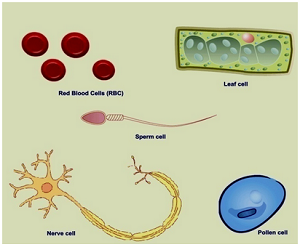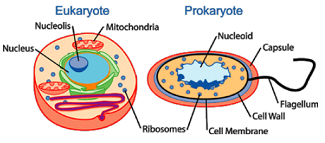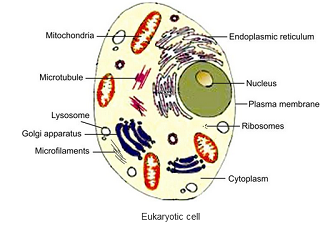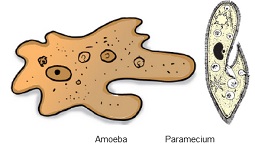
Classification Of Cells
Cell structure and function of Class 8
Classification Of Cells
There are millions of organisms of different designs, shapes and sizes that exist in the living world, though all are made up of cells. To study the detailed structure of cell, they are stained (using dyes) to colour the parts and observed under powerful microscope.
Classification of cells can be done in different type, many classification of cells are based on the following factors.
- In their number
- Shape
- Size
- Complexity
CELL NUMBER:
The number of cells in different organisms is different. Depending on the number of cells the organisms are classified as:
- Unicellular: Organisms made up of single cell are called unicellular (Uni: one; cellular; cell).
|
For example: Amoeba , paramecium , Euglena , Bacteria , etc are unicellular organisms. Although made up of single cell, they perform all the activities necessary for life. They grow, move, digest food, give out wastes and reproduce. All these activities are carried by a single cell. Thus, a single celled organism performs all the necessary functions that multicellular organism performs. |
(a) Amoeba (b) Paramecium |
- Multicellular: The plants and animals that you see around you with the naked eye are made up of many cells. Organisms made up of more than one cell are called multicellular (Multi: many; cellular: cell). It is estimated that a fully grown human has about 100 trillion cells i.e. 10 14 cells. However, life beings with a single cell even in multicellular organisms. This single cell is the fertilized egg which multiplies repeatedly. The number of cells thus increases as development takes place.
CELL SIZE:
The size of cells in living organisms varies a great. It may vary from a few microns (or micrometer; one micron or micrometer = 1 millionth of a metre) to a few centimeters.
However, most of the cell are microscopic in size and are not visible to the unaided eye. They need to be enlarged or magnified by a microscope.
|
Cell type |
Size |
|
|
(i) |
Ostrich egg (largest animal cell) |
170 mm × 130 mm |
|
(ii) |
An unicellular alga ( Acetabularia ) |
10 cm long |
|
(iii) |
Plant fibres (like jute, hemp) |
Few centimeters long |
|
(iv) |
Human Nerve cells (largest in human body) |
Longer than a metre |
|
(v) |
Bacterium, Mycoplasma (smallest cell) |
0.1 × 0.5 micron |
|
(vi) |
Red blood cells (smallest in human body) |
9 microns |

Different cells showing diversity in size and shape
Cell volume:
The volume of a cell :
- Is fairly constant for a particular cell type.
- Is independent of the size of an organism.
CELL SHAPE:
Shape of cells varies not only in different organisms but also in different parts of same organism. Cells may be spherical, oval, elliptical, spindle shaped, cuboidal, polygonal, columnar or flat plate like. Shape of the cell mainly depends upon the function it performs. Other factors which determine the cell shape are : surface tension, viscosity of the protoplasm; rigidity of cell covering ; mechanical pressure of adjoining cells, etc.
Among unicellular organisms:
In Amoeba, a single-celled animal, the body is irregular in shape. In Chlamydomonas, a single-celled plant, the body is oval or round in shape. Paramecium, a unicellular animal, has the shape of a slipper.
Among multicellular organisms:
In leaf epidermis, stomata consisting of two kidney-shaped guard cells enclose a pore in between ; this structure helps in the exchange of gases and loss of water from leaf surface.
In plants, the dividing meristematic cells are isodiametric in shape with no intercellular spaces in between. Xylem and phloem elements are elongated tubular structures so as to help in conduction of water and minerals. The nerve cells are long which enables an efficient communication system. The muscle cells are elongated and contractile, which helps in the movement of bones. These may be flat (e.g. cheek cells and squamous epithelium of alveoli of lung), or cuboidal (e.g. germ cells of gonads) or columnar (e.g. intestine) or polygonal (e.g. liver cells) or rounded (e.g. fat cells). The red blood cells are thin and oval-shaped, so that these can easily move through small spaces and thus permit gaseous exchange. Leucocytes (WBCs) of blood, shape of cells is not fixed due to pseudopodia to engulf the materials.
Related Topics
CELL COMPLEXITY:
On the basis of complexity, cells are of two types.
- Prokaryotic (Pro: Primitive; karyon: nucleus) Cell: The nucleus of the bacterial cell is not well-organized like the cells of multicellular organisms. The cells have nuclear material but no nuclear membrane. The organisms with these kinds of cells are called prokaryotes. Examples are bacteria & blue green algae.
- Eukaryotic (Eu: true; karyon: nucleus) Cell: These cell have well-developed nucleus and are more complex than prokaryotic cells. All organisms other than prokaryotic are eukaryotes.

Differences between Prokaryotic cells and Eukaryotic cells
|
S.No. |
Prokaryotic cell |
Eukaryotic cell |
|
1. |
Size of cell is generally small (1-10 μm). |
Size of cell is generally large (50 to 100 μm). |
|
2. |
Nuclear region is poorly defined, not surrounded by nuclear membrane and therefore called nucleoid and not nucleus. |
Nuclear region is well defined, surrounded by a nuclear membrane. Therefore complete nucleus is present. |
|
3. |
Contains single chromosome. |
Contains more than one chromosome. |
|
4. |
Membrane bound cell organelles absent. However functions of such organelles are also performed by poorly organized parts of the cytoplasm. |
Membrane bound cell organelles such as mitochondria, plastids, endoplasmic reticulum, golgi apparatus, lysosomes, peroxisomes etc. are present. |
|
5. |
Prokaryotic cells are found in bacteria and blue-green algae. |
Eukaryotic cells are found in fungi, plant and animal cells. |

Eukaryotic cell
NCERT solutions for class 8 Science prepared by Physics Wallah will help you to solve your NCERT text book exercise.





